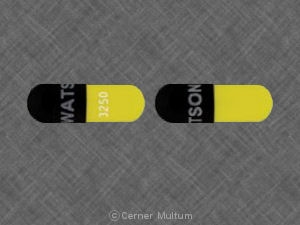

Patients may experience numbness and tingling in a stocking-glove pattern, which may or may not improve upon discontinuation of the drug. Neuropathy is a rare side effect of taking nitrofurantoin. Re-challenge with the drug at a later date is not recommended, as the reaction may have a hypersensitivity component and recur when the drug is resumed. If signs of liver failure are observed in a patient taking nitrofurantoin, the drug should be discontinued. These reactions usually occur after exposure to the drug for more than 6 weeks. The onset of chronic active hepatitis may be insidious, and patients should be monitored periodically for changes in biochemical tests that would indicate liver injury. Hepatic reactions, including hepatitis, cholestatic jaundice, chronic active hepatitis, and hepatic necrosis, occur rarely. It is important to recognize nitrofurantoin as possible cause of symptoms and discontinue the drug when the suspicion of pulmonary side effects arises as it can be reversible if the drug is stopped early. This reaction manifests with progressive shortness of breath. This uncommon reaction may occur 1 month to 6 years after starting the drug and is usually related to its total lifetime dose. Ĭhronic pulmonary reactions caused by nitrofurantoin include diffuse interstitial pneumonitis, pulmonary fibrosis, or both. Treatment includes discontinuation of the nitrofurantoin, which should result in symptom improvement within 24 hours. Chest radiograph will often show unilateral or bilateral infiltrates similar to pulmonary edema. Symptoms include fever, dyspnea, chills, cough, pleuritic chest pain, headache, back pain, and epigastric pain. These reactions usually develop 3–8 days after the first dose of nitrofurantoin, but may occur from a few hours to a few weeks after starting the drug. Acute reactions have been estimated to occur in about one in 5000 women who take the drug. The acute and subacute reactions are thought to be due to a hypersensitivity reaction and often resolve when the drug is discontinued. The pulmonary toxicity caused by nitrofurantoin can be categorized into acute, subacute, and chronic pulmonary reactions. These include pulmonary reactions, hepatotoxicity, and neuropathy. Some of the more serious but rare side effects of nitrofurantoin have been a cause of concern. Patients should be informed that nitrofurantoin colours urine brown this is completely harmless. Respiratory: acute pulmonary hypersensitivity reaction.Neurologic: dizziness, drowsiness, amblyopia.Gastrointestinal: diarrhea, dyspepsia, abdominal pain, constipation, emesis.Less common adverse events (occurring in less than 1% of those taking the drug) include:

The most common side effects with nitrofurantoin are nausea, headache, and flatulence. A 2015 meta analysis found no increased risk from first trimester use in cohort studies that was a slight increase of malformations in case control studies. They remain a first line treatment in the second trimester. The American College of Obstetricians and Gynecologists states that while they can be used in the first trimester other options may be preferred. Įvidence of safety in early pregnancy is mixed as of 2017. Newborns of women given this drug late in pregnancy had a higher risk of developing neonatal jaundice. It however should not be used in late pregnancy due to the potential risk of hemolytic anemia in the newborn. It is one of the few drugs commonly used in pregnancy to treat UTIs. Nitrofurantoin is pregnancy category B in the United States and pregnancy category A in Australia. Many or all strains of the following genera are resistant to nitrofurantoin: Īntibiotic susceptibility testing should always be performed to further elucidate the resistance profile of the particular strain of bacteria causing infection. It is used in the treatment of infections caused by these organisms. Nitrofurantoin has been shown to have good activity against: Nitrofurantoin is not recommended for the treatment of pyelonephritis, prostatitis, and intra-abdominal abscess, because of extremely poor tissue penetration and low blood levels. The efficacy of nitrofurantoin in treating UTIs combined with a low rate of bacterial resistance to this agent makes it one of the first-line agents for treating uncomplicated UTIs as recommended by the Infectious Diseases Society of America and the European Society for Microbiology and Infectious Diseases. Increasing bacterial antibiotic resistance to other commonly used agents, such as trimethoprim/sulfamethoxazole and fluoroquinolones, has led to increased interest in using nitrofurantoin. Current uses include the treatment of uncomplicated urinary tract infections (UTIs) and prophylaxis against UTIs in people prone to recurrent UTIs.


 0 kommentar(er)
0 kommentar(er)
